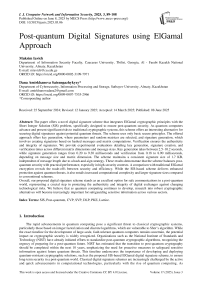Post-quantum Digital Signatures using ElGamal Approach
Автор: Maksim Iavich, Dana Amirkhanova Sairangazhykyzy
Журнал: International Journal of Computer Network and Information Security @ijcnis
Статья в выпуске: 3 vol.17, 2025 года.
Бесплатный доступ
The paper offers a novel digital signature scheme that integrates ElGamal cryptographic principles with the Short Integer Solution (SIS) problem, specifically designed to ensure post-quantum security. As quantum computers advance and present significant risks to traditional cryptographic systems, this scheme offers an interesting alternative for securing digital signatures against potential quantum threats. The scheme uses only basic secure principles. The offered approach offers key generation, where parameters and random matrices are selected, and signature generation, which involves creating signatures based on hashed messages and matrix computations. Verification ensures the authenticity and integrity of signatures. We provide experimental evaluations detailing key generation, signature creation, and verification times across different matrix dimensions and message sizes. Key generation takes between 2.5–10.2 seconds, while signature generation ranges from 0.20 to 9.30 milliseconds and verification from 0.18 to 8.90 milliseconds, depending on message size and matrix dimension. The scheme maintains a consistent signature size of 1.7 KB, independent of message length due to a hash-and-sign strategy. These results demonstrate that the scheme balances post-quantum security with practical performance, especially in high-security contexts. A comparison with traditional ElGamal encryption reveals the trade-offs between security and efficiency. While the SIS-based scheme delivers enhanced protection against quantum threats, it also entails increased computational complexity and larger signature sizes compared to conventional schemes.
SIS, Post-quantum, CVP, SVP, DLP, PKE, Lattice
Короткий адрес: https://sciup.org/15019801
IDR: 15019801 | DOI: 10.5815/ijcnis.2025.03.06


